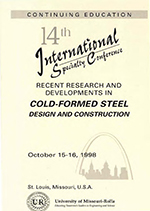Session Dates
15 Oct 1998
Abstract
Current design of cold-formed steel members is unduly complicated, Part of this complication arises from the need to perform elastic buckling calculations by hand. Also, complications occur in determining the effective width and resulting effective properties of members. Further, as cross-sections become more optimized (e.g., through the introduction of longitudinal stiffeners) both the elastic buckling and effective width calculations become markedly more complex. In order to investigate alternatives to current design a large amount of experimental data on flexural members of varying geometry is collected. The use of numerical elastic buckling solutions for the entire member, is investigated as an alternative to current practice. Employing strength curves on the entire member, similar to the effective width strength curves for an element, it is found that a "direct strength" approach is a reliable alternative to current design. Such an approach leads to complete flexibility in cross-section geometry, thus greatly increasing the ability to optimize cold-formed steel members. Conservative limitations of the direct strength approach are also addressed.
Department(s)
Civil, Architectural and Environmental Engineering
Research Center/Lab(s)
Wei-Wen Yu Center for Cold-Formed Steel Structures
Meeting Name
14th International Specialty Conference on Cold-Formed Steel Structures
Publisher
University of Missouri--Rolla
Document Version
Final Version
Rights
© 1998 University of Missouri--Rolla, All rights reserved.
Document Type
Article - Conference proceedings
File Type
text
Language
English
Recommended Citation
Schafer, Benjamin W. and Pekoz, Teoman, "Direct Strength Prediction of Cold-formed Steel Members Using Numerical Elastic Buckling Solutions" (1998). CCFSS Proceedings of International Specialty Conference on Cold-Formed Steel Structures (1971 - 2018). 4.
https://scholarsmine.mst.edu/isccss/14iccfsss/14iccfsss-session2/4
Direct Strength Prediction of Cold-formed Steel Members Using Numerical Elastic Buckling Solutions
Current design of cold-formed steel members is unduly complicated, Part of this complication arises from the need to perform elastic buckling calculations by hand. Also, complications occur in determining the effective width and resulting effective properties of members. Further, as cross-sections become more optimized (e.g., through the introduction of longitudinal stiffeners) both the elastic buckling and effective width calculations become markedly more complex. In order to investigate alternatives to current design a large amount of experimental data on flexural members of varying geometry is collected. The use of numerical elastic buckling solutions for the entire member, is investigated as an alternative to current practice. Employing strength curves on the entire member, similar to the effective width strength curves for an element, it is found that a "direct strength" approach is a reliable alternative to current design. Such an approach leads to complete flexibility in cross-section geometry, thus greatly increasing the ability to optimize cold-formed steel members. Conservative limitations of the direct strength approach are also addressed.



